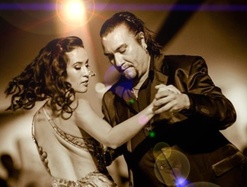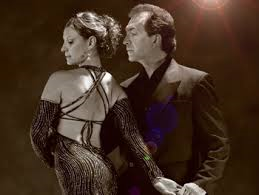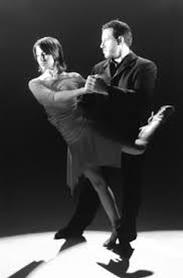Tango nuevo
As its name implies, tango nuevo is a 'new' kind of tango. It is often confused with electrotango (modern, electronic tango music), or with a kind of 'neo' aesthetic which draws on modern dance to create a distinctive stylistic break with traditional tango. But it is wrong to conflate tango nuevo with any particular kind of music, style or fashion.
Actually, first-generation tango nuevo was above all a conceptual and pedagogic innovation - put simply, it was a new way of thinking about and learning/teaching/sharing tango. That is what we mean when we say we teach from a nuevo perspective, and dance contemporary salon incorporating nuevo.
Actually, first-generation tango nuevo was above all a conceptual and pedagogic innovation - put simply, it was a new way of thinking about and learning/teaching/sharing tango. That is what we mean when we say we teach from a nuevo perspective, and dance contemporary salon incorporating nuevo.
Creative, innovative, individual
|
Tango developed rapidly from the early 1990s to 2000s, and this was primarily because of the input and influence of those coming from the 'nuevo' approach. The key originators of this new perspective were Gustavo Naveira (our longest-standing teacher and mentor - click here), Fabian Salas and, later, Chicho Frumboli.
Whilst in salon, much 'teaching' was limited to 'copying the teacher until it looks the same', the nuevo approach reflected pedagogical improvements, and was concerned with teaching people to improvise, rather than 'training' them to copy their predecessors. |
Gustavo Naveira & Giselle Anne
|
Tango has always been a dance of innovation and change (no restrictive syllabuses, exams or medals to hold back the dance's development). But in the nuevo approach, there is an even greater emphasis on the creation of new steps and movements, so that there are more distinct differences between one couple's dance and another's. The tango danced by Chicho/Sepulveda is utterly different from that danced by Salas/del Rivero, and different again from that of Naveira/Anne.
How to spot nuevo

Nuevo is characterised by a changeable and more elastic embrace, and a greater emphasis on fluidity and continuity of movement. The axis moves between the couple and around the floor more markedly. Strong pivots and dissociation allow for the inclusion of a higher number of overturned ochos, sacadas, displacements and 'off-axis' steps. It can be innovative, ingenious, surprising and exciting, but it does require a good grounding in traditional tango technique, as it demands excellent balance, posture and pivoting. If it is to feel and look good, it demands excellent musicality.
Chicho Frumboli & Juana Sepulveda
If there are features that connect the best nuevo dancers, they are probably an increased emphasis on innovation, ingenuity and fluidity; a lack of complete, recognisable, traditional tango sequences; and a rather different relationship between the man and the woman. Our own experience of learning and dancing nuevo is that the demands on the follower are considerably higher than is typical in social salon tango, and that the relationship between leader and follower is more equal.
But always tango...
|
Interestingly, most of these renowned tangueros insist that they dance 'salon', or 'just tango'. They reject the word 'nuevo' because it implies that they are dancing a 'new' dance; instead they feel that they are only looking afresh at what is already there, and discovering tango's hidden and latent possibilities. They respect the long-standing traditions of tango, and its beautiful music (some of them will not dance to electrotango). They, and we, believe that 'nuevo' should not look starkly, stylistically different from traditional salon tango: it should be an exciting extension of what went before, coming from deeper conceptual understanding.
Nuevo is not an opportunity to blend tango with other dances or add in whatever stylistic tics one chooses. These superfluous additions are unnecessary, ugly and arise from a lack of understanding of what real tango is. Creating your own tango |
Fabian Salas
& Carolina del Rivero |
Tango nuevo primarily arose as a new way of conceptualising the movements of tango dancing - and relatedly, a new way of teaching. Its innovative qualities arise from working out in a logical and methodical way the range of possibilities inherent within a movement, taking into account the different relationships possible between the partners. For instance, you may hear a teacher speak about the range of possible forward sacadas thus: front (crossed step) to side (step), front to front, front to back, all of which can be done on the left or the right. By thinking in this way, new combinations and movements can be more easily discovered. We often use this approach to tango when we create steps and sequences for our classes, and use it in our teaching at all levels.
It has been said that 'Tango nuevo is the physical expression of an academic discipline, the result of an intellectual exercise.' Certainly, the 'nuevo' approach to tango is more analytical and conceptual, and encourages a 'thinking' dancer who is open to innovation and strong on technique. Our own teaching falls within this tradition - and we have learned most from those teachers who understand tango in this way. We teach our students the nuevo conceptual framework, so that they can go on to invent and improvise authentic new tango movements for themselves.
For us, this is tango for the 21st century.
It has been said that 'Tango nuevo is the physical expression of an academic discipline, the result of an intellectual exercise.' Certainly, the 'nuevo' approach to tango is more analytical and conceptual, and encourages a 'thinking' dancer who is open to innovation and strong on technique. Our own teaching falls within this tradition - and we have learned most from those teachers who understand tango in this way. We teach our students the nuevo conceptual framework, so that they can go on to invent and improvise authentic new tango movements for themselves.
For us, this is tango for the 21st century.
Read about other authentic tango styles by clicking below:
Page updated 26th March 2015

